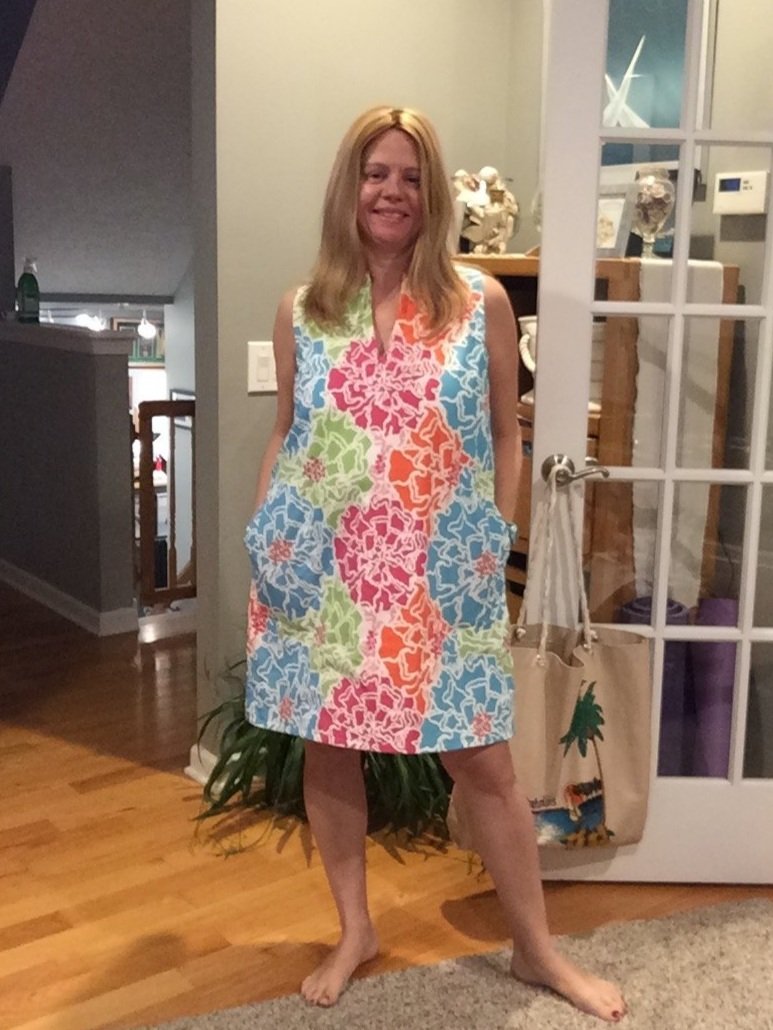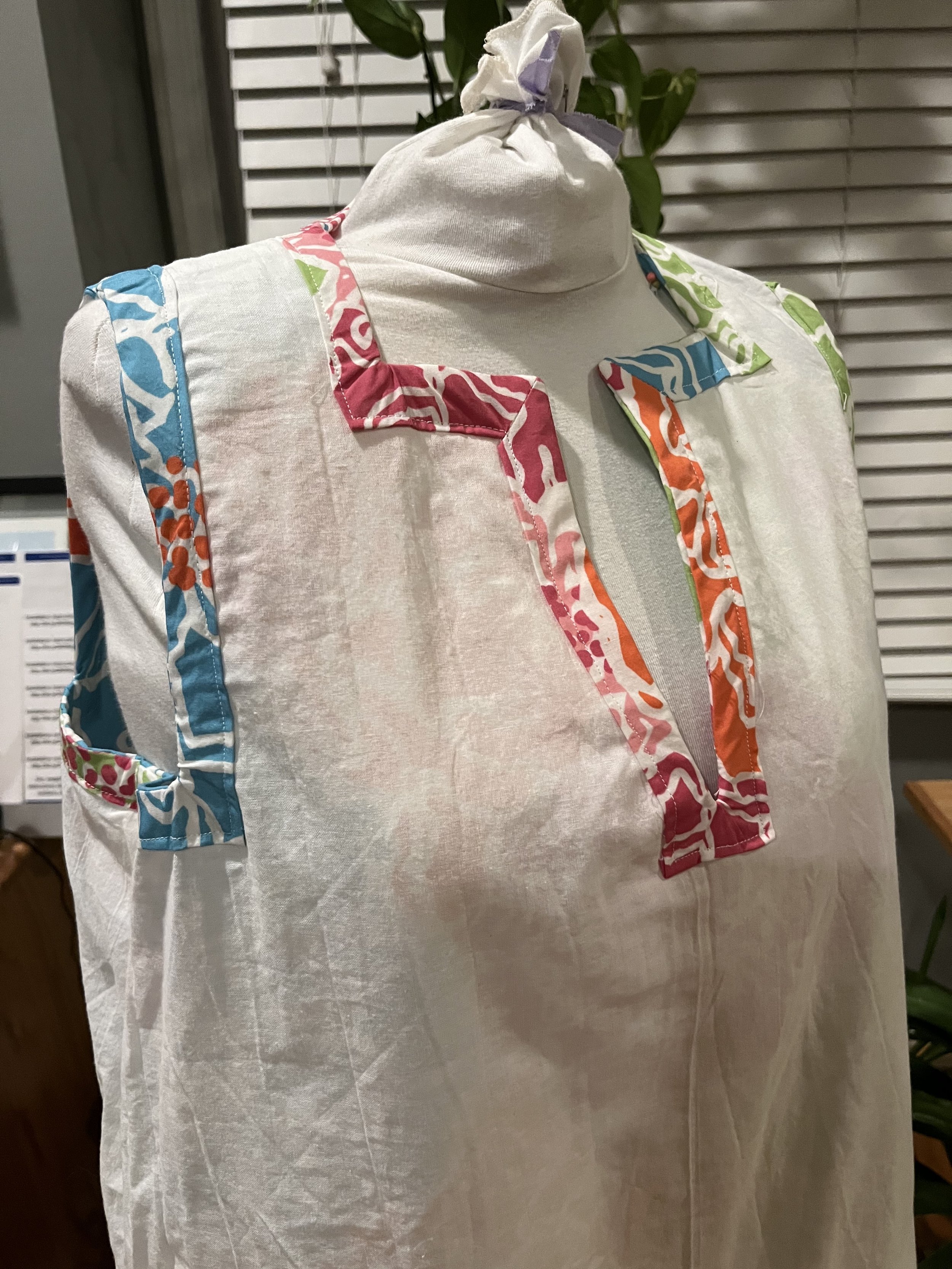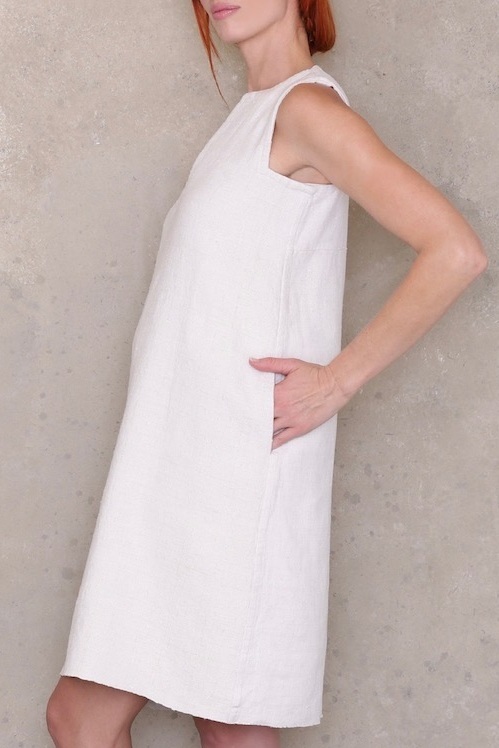Ann Normandy Shift Dress Sewing Pattern in Spoonflower Printed Cotton Poplin
By guest blogger, Ann Siegle
I loved sewing the Ann-Normandy Shift Dress Sewing Pattern in Spoonflower printed cotton poplin fabric. Here’s my take on how to do the underlining and sew the dress in a fabric that would normally be too lightweight for this pattern.
I knew when I saw this dress pattern, it was perfect for this fabric. I love the Lilly dresses (you know, the Palm Beach bright tropical print designer…) During the Target collaboration with Lilly, I loved the dresses – but not the feeding frenzy and exorbitant eBay resale fees for them. I ordered the Spoonflower print from an indie designer on the platform, specifically to get that bright, beachy print look for this dress. Other options include Bahamas Handprints for a similar tropical handprint fabric vibe. Fun fact, Key West Handprints (now out of business) once made the designs for the Lilly official fabrics!
In the instructions in the pattern packet include how to underline the dress if you don’t have heavyweight linen. I did my underlining of this dress a little different, so I’ll share what I did and the steps I took.
I sewed a Large (L) in this dress. I’m a 34DD bust. The dress is an A-line, above-the-knee shape so otherwise, there are no fitting areas to tackle beyond your fit in the upper bust/full bust. I made no bust alterations, just cut the L.
I cut out two dress main body panels – one in the printed poplin, one in white cotton fabric from stash (bleached muslin, but a similar cotton poplin would be perfect.) The fabric I used for the main fabric is the Spoonflower Cotton Poplin, which retails for $20 / yard. They also have a cotton lawn that would be perfect (if lined as I did.)
Underlining a dress is different than LINING a dress, and the instructions call for underlining. I did a combination of these two methods, and I’ll explain what I did:
Cut out main and lining fabric.
(From the instructions in the pattern packet), align the underlining and the main fabric wrong sides together, baste close to all edges, and then treat the pieces as one piece of fabric for the rest of the construction.
Ann’s version: Sew the side seams of the lining of the dress ONLY and set aside. Construct the pocket and side seam of dress
Ann’s version, using just the front pattern piece and the pocket pieces
Once the side seams are constructed on the dress – note, I did NOT flat fell these since they will be lined fully – slide the lining inside the dress wrong sides together and pin the neck and shoulders. Note, at this point the shoulder seams are NOT sewn. The entire top of the dress is open, the lining is mated with the dress, wrong sides together.
Sew the neckline binding as per the pattern instructions.
Sew the shoulder and back neck seam per the instructions.
Sew the armscye binding per the instructions.
Press the whole dress, aligning the raw hem edges. Turn up BOTH edges, treating them as one, press. Fold up again (as per the instructions) and stitch the hem. The lining will be encapsulated in the hem completely – it won’t be a free lining at the bottom. Optionally, you can hem them separately, making sure the lining is hemmed ¼” shorter than the dress.
The only MAJOR change I made was the side seam – instead of flat felling those, they are just stitched and the lining covers the raw edges of both of them. I lengthened the pockets too.
This dress looks as gorgeous on the inside as the outside – and I’d also suggest that if you have two printed poplins that coordinate, you could use this technique to make the dress reversible. The bands along the neck and armscyes will show on the reverse side but you can design that in with contrast or coordinating fabrics. In this case, you’d hem the dress and lining separately, making them equal lengths.
My favorite details: The POCKETS – super awesome. You can cut them even larger (like I did) for more storage capacity. I added 1” to the length of the pockets.
The neckline – it’s so flattering! The squared off V neck is distinctive. And the underarms? They are magical! They fit well and they are interesting. Who loves interesting armholes? Bet you never thought you’d say that! But you’ll love these.
In my companion blog post, on my own blog, I share a big oops moment with a tear that derailed my project (and how I got it back on track!)
Of course, this dress will be perfect to wear in Palm Beach (or your favorite beach town). But it’s also a divine summer dress for everyday wear. I live a casual life – I work from home, I’m a mom of two teenagers with busy sports schedules, so this dress will be a toss-and-go dress with sandals and sunglasses from June to September.
The dress is designed for heavyweight linens, and if you can’t find printed linens, you can try the Spoonflower Belgian linen from Libeco for this dress – it’s 9.8oz/yd, so it would fit within the parameters for this dress. You can find solid color linens at your local fabric store, or fabric-store.com online. Naturally in a navy or black, this is a perfect Little Black Dress for wear all year round, but even in warner months, it would be sleek and sophisticated in a slate blue or soft gray linen, or, as I’ve done, use two printed poplin fabrics underlined together to create a wonderful summer dress.
In short, I highly recommend the Ann-Normandy Shift Dress sewing pattern.
Ann Siegle is a sewist in East Lansing, MI. She has a sewing blog at Sew Paradise, click here for more of her review of the Shift Dress PDF sewing pattern. Ann has a “French style” capsule wardrobe featuring Ann Normandy Patterns. As well as the “oops, mistake and fix” blog post!
Create your Shift Dress with the Ann Normandy Design Shift Dress PDF sewing pattern.
Check out Spoonflower for every imaginable print possible, or keep it simple such as crisp white or black linen.
What’s new with the Sleeveless Shift Dress sewing pattern:
We’ve recently extended our sizes range to XS - 2X
Newly updated step by step sewing instructions and photos.





